A Whale of a Tale
The largest mammal at the Museum is interviewed by the largest dinosaur
Titanosaur: Good morning, blue whale . Thanks for taking the time to talk to me! It’s an honor.
Blue Whale: Thanks, Titanosaur ! The honor is all mine. You can just call me Blue.
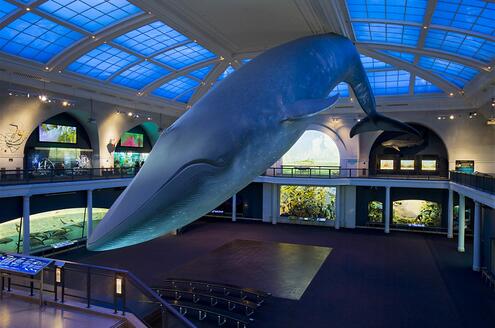
Titanosaur: Will do, Blue. Wow, you’re big! I’m pretty big myself. I’m 37 meters (122 feet) long. But you might be even bigger.
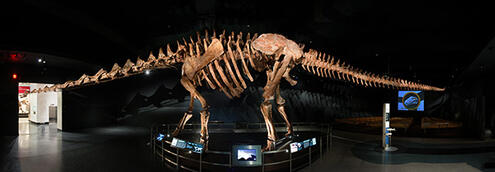
Blue Whale: Well, you’re definitely a lot longer. I’m only 29 meters (94 feet) long!
Titanosaur: So, Blue, here’s something I’ve been wondering. Many of the other animals here in the Museum are actual specimens. Some are shells, some are fossils , and some are animal skins that have been preserved and stuffed. Other animals on display here are casts, like me. Many of my “bones” are exact replicas of real fossil dinosaur bones. I’m actually made out of fiberglass. What about you? Are you a real blue whale?
Blue Whale: Goodness, no! You’d never be able to hang a real blue whale from the ceiling. They can weigh as much as 168 metric tons (370,000 pounds). That’s as heavy as 28 African elephants! Blue whales are the largest animals that ever lived on Earth .
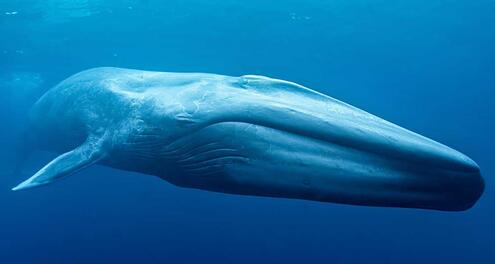
Titanosaur: Wow, that’s much more massive than the dinosaur whose fossils I was molded after. With flesh and bones, scientists think the titanosaur only weighed around 70 tons (140,000 pounds).
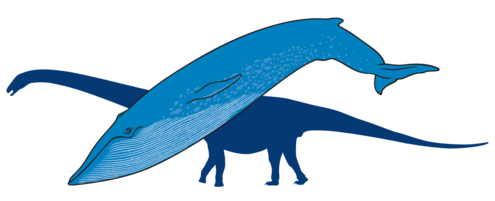
Blue Whale: It was a shrimp compared to a blue whale! Speaking of shrimp, blue whales eat small shrimp-like creatures called krill. Each whale eat about 40 million krill a day! They take in gigantic mouthfuls of seawater with krill swimming in it. Then they shut their mouths and push the water out through their bristle-like teeth, which are made of stiff but flexible stuff called baleen. The krill get caught behind in the baleen, and dinner is served!
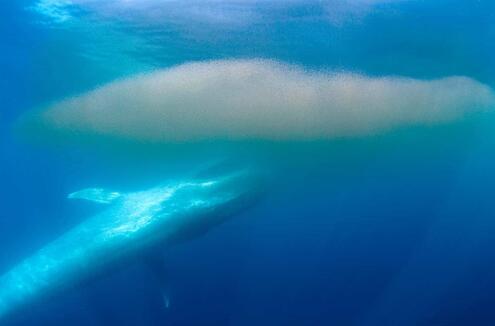
Titanosaur: Bon appétit! So, are you a cast, like me?
Blue Whale: No, I’m not a cast either. I’m a model that artists made based on a real blue whale specimen. I am made of foam and fiberglass on top of an iron frame. And I’m mostly hollow inside. As a model I’m much lighter than a real blue whale, but I still weigh 9,500 kilograms (21,000 pounds)!
Titanosaur: That’s still pretty heavy! How come you don’t fall off the ceiling?
Blue Whale: I’m connected to the roof by a sturdy steel pipe.
Titanosaur: That must be a big pipe!
Blue Whale: Not all that big. It’s only 16 inches thick. But it doesn’t do all the work. It’s connected to other steel bars and structures in the ceiling, which helps transfer my weight all over.
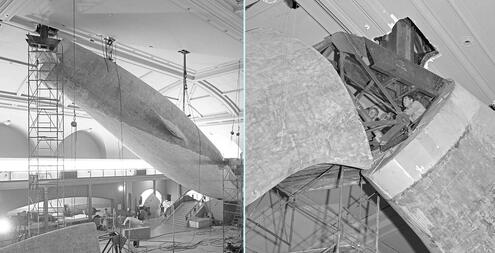
Blue Whale: Not all that big. It’s only 16 inches thick. But it doesn’t do all the work. It’s connected to other steel bars and structures in the ceiling, which helps transfer my weight all over.
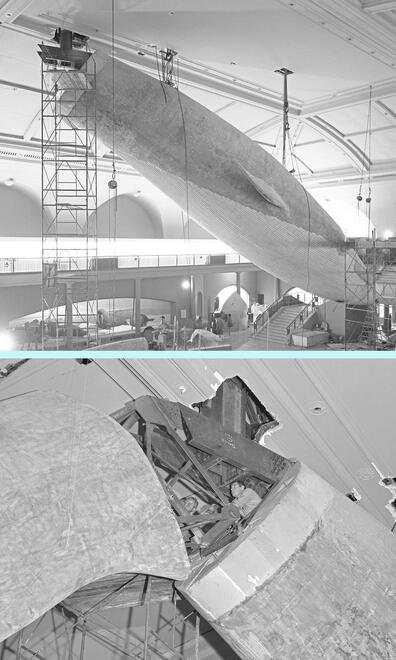
Titanosaur: That’s amazing engineering. I can hardly see the pipe at all. And it looks like you’re floating in the air. Actually, with the ceiling’s shimmering blue skylights, it looks like you’re swimming right below the surface of the ocean!
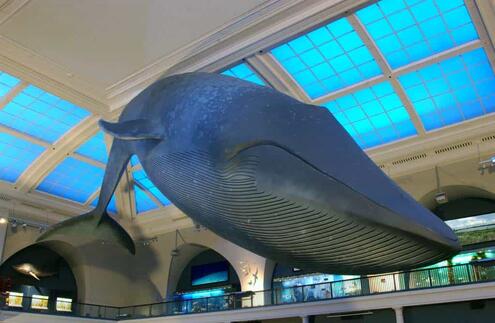
Blue whale: You’re right, it does!
Titanosaur: So what blue whale were you modeled on? Was there a particular one?
Blue Whale: When I was first constructed in the mid-1960s, scientists didn’t have a lot of evidence of what living blue whales looked like. So Museum artists modeled me after photographs of a female blue whale that was found dead in 1925 off the southern tip of South America.
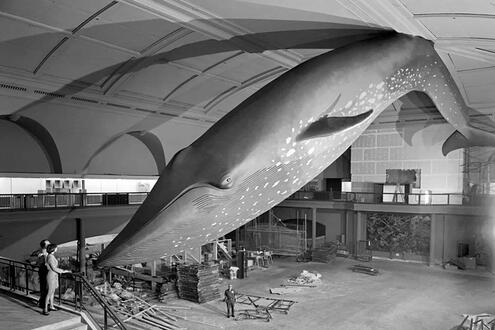
Titanosaur: You were modeled after a dead whale? But you look quite lively!
Blue Whale: Why, thank you. When the Museum renovated the Milstein Hall of Ocean Life in the early 2000s, I got a renovation too! By then, artists had plenty of new evidence to go on. They can study photos and videos of live blue whales swimming underwater.
Titanosaur: What did they change?
Blue Whale: Lots of things. They flattened my bulgy eyes, tapered my tail, and made my blowholes more accurate. They repainted my skin. It took about 25 gallons of paint! And my favorite part: They finally gave me a belly button.
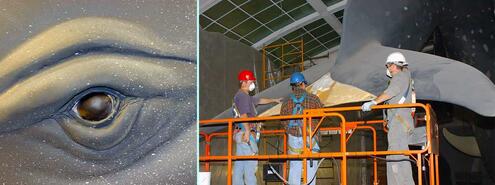
Blue Whale: Lots of things. They flattened my bulgy eyes, tapered my tail, and made my blowholes more accurate. They repainted my skin. It took about 25 gallons of paint! And my favorite part: They finally gave me a belly button.
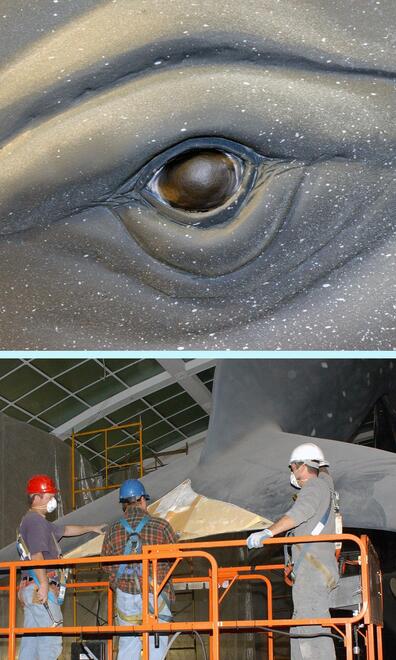
Titanosaur: Wow! I don’t have one of those.
Blue Whale: Of course not! Dinosaurs hatch from eggs. Only mammals have belly buttons. Besides, you’re a skeleton. Skeletons definitely don’t have belly buttons.
Titanosaur: They did a great job with your paint. How do you keep the dust off?
Blue Whale: Thanks! I get a bath once a year, whether I need it or not.
Titanosaur: A bath? Really? I didn’t know the Museum had a tub that big!
Blue Whale: Okay, okay, it’s not a bath exactly. Call it a scrub down. And it takes a long time! Members of the Exhibitions Department use long-handled brushes and vacuums to clean off the dust. It tickles, especially when they get near my blowholes. Fortunately, whales don’t sneeze.
Titanosaur: Especially fiberglass models of whales. Thanks for talking with me, Blue.
Blue Whale: Thanks, Titanosaur!
You might also like...
Image Credits:
©AMNH/ Liz Vernon; Whale tail illustration, ©AMNH/Liz Vernon; whale icon, ©AMNH; titanosaur cartoon, ©AMNH; Whale in Hall of Ocean Life, ©Craig Chesek/AMNH; Blue whale in ocean, ©Mike Johnson/BluePlanetArchive.com; Blue whale & titanosaur comparison, ©AMNH; Blue whale feeding on krill, ©Richard Herrmann/Minden Pictures; whale construction and pipe closeup, ©AMNH; Whale in hall as seen from below, ©AMNH; Early photo of whale in hall, ©AMNH; Closeup of whale's eye and construction team working on whale tail, ©AMNH; Workers inspecting tail of blue whale model, ©AMNH.




 Biodiversity
Biodiversity
 Brain
Brain
 Genetics
Genetics
 Marine BiOLogy
Marine BiOLogy
 MicrobiOLogy
MicrobiOLogy
 PaleontOLogy
PaleontOLogy
 ZoOLogy
ZoOLogy
 AnthropOLogy
AnthropOLogy
 ArchaeOLogy
ArchaeOLogy
 Astronomy
Astronomy
 Climate Change
Climate Change
 Earth
Earth
 Physics
Physics
 Water
Water
